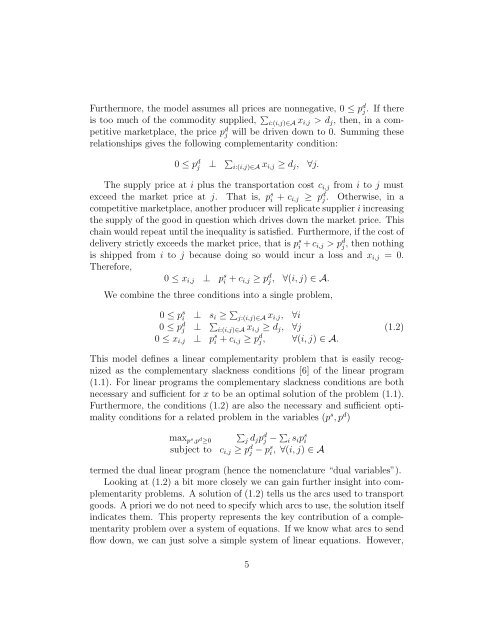GAMS/PATH User Guide Version 4.3
GAMS/PATH User Guide Version 4.3
GAMS/PATH User Guide Version 4.3
You also want an ePaper? Increase the reach of your titles
YUMPU automatically turns print PDFs into web optimized ePapers that Google loves.
Furthermore, the model assumes all prices are nonnegative, 0 ≤ p d j .Ifthere<br />
is too much of the commodity supplied, <br />
i:(i,j)∈A xi,j >dj, then, in a competitive<br />
marketplace, the price p d j will be driven down to 0. Summing these<br />
relationships gives the following complementarity condition:<br />
0 ≤ p d j<br />
⊥ <br />
i:(i,j)∈A xi,j ≥ dj, ∀j.<br />
The supply price at i plus the transportation cost ci,j from i to j must<br />
exceed the market price at j. That is, ps i + ci,j ≥ pd j. Otherwise, in a<br />
competitive marketplace, another producer will replicate supplier i increasing<br />
the supply of the good in question which drives down the market price. This<br />
chain would repeat until the inequality is satisfied. Furthermore, if the cost of<br />
delivery strictly exceeds the market price, that is ps i + ci,j >pd j , then nothing<br />
is shipped from i to j because doing so would incur a loss and xi,j =0.<br />
Therefore,<br />
0 ≤ xi,j ⊥ ps i + ci,j ≥ pd j , ∀(i, j) ∈A.<br />
We combine the three conditions into a single problem,<br />
0 ≤ ps i ⊥ si ≥ <br />
0 ≤ p<br />
j:(i,j)∈A xi,j, ∀i<br />
d j ⊥ <br />
0 ≤ xi,j ⊥<br />
i:(i,j)∈A xi,j ≥ dj,<br />
p<br />
∀j<br />
s i + ci,j ≥ pd j, ∀(i, j) ∈A.<br />
(1.2)<br />
This model defines a linear complementarity problem that is easily recognized<br />
as the complementary slackness conditions [6] of the linear program<br />
(1.1). For linear programs the complementary slackness conditions are both<br />
necessary and sufficient for x to be an optimal solution of the problem (1.1).<br />
Furthermore, the conditions (1.2) are also the necessary and sufficient optimality<br />
conditions for a related problem in the variables (p s ,p d )<br />
maxps ,pd≥0 subject to ci,j ≥ pd j − psi <br />
j djpd j − <br />
i sips i<br />
, ∀(i, j) ∈A<br />
termed the dual linear program (hence the nomenclature “dual variables”).<br />
Looking at (1.2) a bit more closely we can gain further insight into complementarity<br />
problems. A solution of (1.2) tells us the arcs used to transport<br />
goods. A priori we do not need to specify which arcs to use, the solution itself<br />
indicates them. This property represents the key contribution of a complementarity<br />
problem over a system of equations. If we know what arcs to send<br />
flow down, we can just solve a simple system of linear equations. However,<br />
5

















